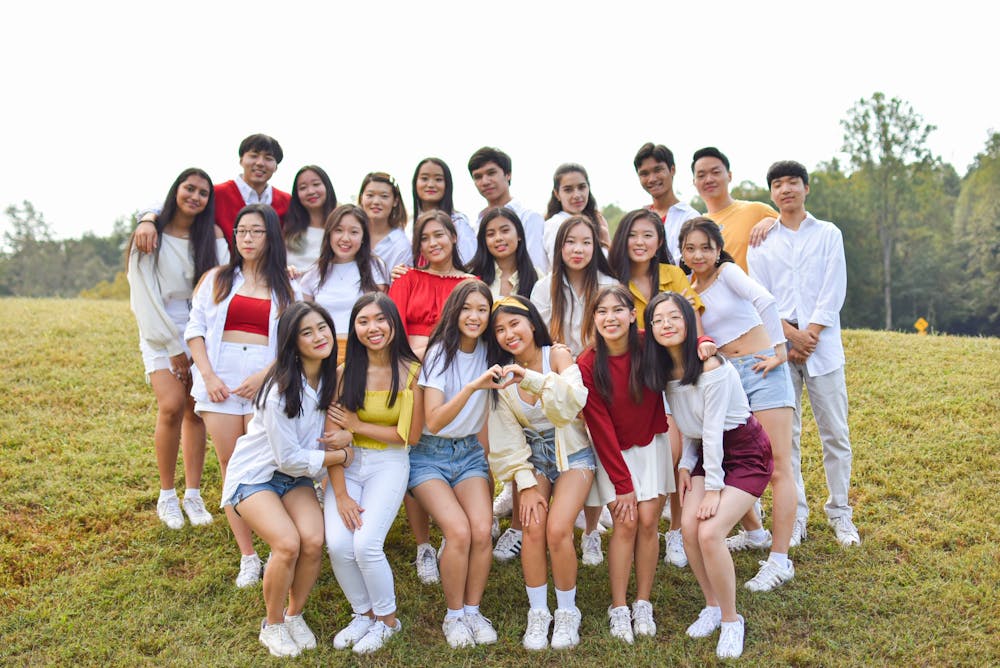Through the community and cultural bonds fostered by “K-Edge,” the University’s first audition-based Korean interest dance group, what started as a typical K-Pop based dance group, has evolved into more. It has become a home for members to unify and celebrate their love and passion for one another, dance and Korean culture, all while nurturing core values of hardwork and discipline.
In just four years, what started as a small group of interested dancers — learning and practicing various dances in practice rooms whenever they could find time — evolved into a dedicated family of about 20 active members who are recognized across Grounds as K-Edge dancers.
Agatha Tatang, third-year College student and vice president of K-Edge, shared the history of K-Edge and how it was founded on “a whole lot of hope,” as described on their official website. According to Tatang, K-Edge started as a small group of friends interested in dance with K-pop but had no outlet to join.
It starts with an audition at the beginning of the fall or spring semester. Interested auditionees will learn two dance pieces over the course of a week, culminating in an audition on the Friday of that week.
“Auditionees have to learn a girl and boy piece,” Tatang said. “We value versatility. We know people won’t be equal in both areas, but we do want people to be able to do both. It is quite hard to learn two pieces in one week –– even our members have a hard time, but we’ll take people by threes, they do each song twice, and we do callbacks after that.”
K-Edge accepts whoever they feel would be an asset to the team, so the number of accepted auditionees varies from semester to semester. This past semester, they had eight new members. Once someone is accepted, dues are $15, and they are officially a member of K-Edge.
As the only audition-based K-pop dance group on Grounds, K-Edge takes their passion seriously, constantly challenging performers to work their hardest and cultivate their skills both on and off the stage.
“We usually have practices twice a week, Thursdays and Sundays, but we also have subgroups, so you’ll be practicing more hours a week depending on your subgroup’s decision,” Tatang said. “If it’s ... a week or two before a performance, we have ‘hell week’ extra practices, which are five hours.”
First year Architecture student Nguyen Duong is a new K-Edge member or as they’re called within the organization a new “baby.” Duong explained what she feels sets the group apart from others and how it is special to her.
“I love K-Edge’s rigorous energy and their seriousness when it comes to dancing,” Duong said. “That’s a very essential element when it comes to the learning environment. I’ve been in clubs before, and it always bothers me when everyone is goofing around and not paying attention to leaders, so the result is not as good as expected. I joined K-Edge because I love the environment and dedication they have for dancing.”
K-Edge practices and performs to a variety of K-pop music, so their dances use a wide range of styles. They primarily focus on learning covers of original K-pop group dances. The group differs from many other K-pop dance groups because it ensures that the wide variety of members’ talents are showcased. Dances are typically performed by four group members. However, their rendition will include many more members in order to allow more performers to do a dance they like.
The teams’ performances and Youtube videos have garnered positive attention across the K-op dance group world. They participated in their first competition Nov. 2 at Virginia Tech and won first place in the boy’s division. They have since received a competition invitation in North Carolina and look to continue competing and showing off their dance sets.
Ian Tucker, fourth-year Engineering student and current president of K-Edge, explained the choreography process and how the group chooses their sets of dances to be performed for shows.
“When a K-pop group comes out with songs, there’s usually a dance associated with it,” Tucker said. “If certain individuals happen to like said choreography, they can learn it for what we call ‘Demo Day.’ They show it to the team and the team votes which pieces they enjoyed the most and what they want to do for the performances.”
The common denominator that initially brought K-Edge together was the members’ love and appreciation for Korean culture and music. As the group has grown, they’ve valued building a family –– a community of dancers with different strengths and weaknesses.
“Our primary goal would be to spread a love and interest in K-pop, but I feel like our performances help show how fun K-pop is and how diverse and dynamic Korean pop and performances can be,” Tatang said. “We feel like a whole unit when we perform. It’s a feeling of being a part of something that is bigger than you. It’s very fun to hear the crowd’s screams and cheers.”
Even though the group stresses hard work and talent, K-Edge seeks to entertain while fostering values of growth and improvement.
“It’s not always just the cream of the crop who make the team, [so] you don’t have to be the best of the best,” Tucker said. “A lot of the times, we will see potential in people who audition, [and] we will see that they have the potential to shine in certain pieces. We want to teach these dancers how to go outside of their comfort zone and how to really flourish in different styles of dance.”
Correction: This article previously called K-Edge the first K-Pop dance group on Grounds, but it is actually the first audition-based K-Pop dance group on Grounds. Also, Nguyen Duong was initially introduced with male pronouns, and has been updated with her correct pronouns.







